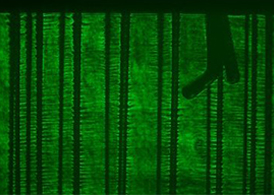


On COBRA, three Canon digital EOS cameras with high resolution CCD chips, are used in conjunction with a frequency-doubled Nd:YAG laser (532 nm) to produce 150-ps time-resolved laser shadowgraph images. The main beam of the laser source is split into three channels to provide various frame times (about 10 ns between frames). This is accomplished simply by varying the path lengths of the three beams prior to their passage through the experiment chamber. The images produced are due to a Schlieren-like process, where parts of the imaging beam are refracted by density gradients in the plasma. The rays that are refracted only slightly by relatively mild density gradients are collected and focused by imaging optics, while rays that are refracted to larger angles by sharper density gradients are scattered out of the collection cone of the imaging optics. This process is not properly called Schlieren imaging, however, as there is no beam stop at the focal point of the unperturbed rays. Also, it should be mentioned that complete reflection of an imaging photon will occur wherever the plasma density is high enough such that the electron plasma frequency exceeds the laser frequency. As the frequency of a 532-nm laser is 5.6×1014 Hz, the corresponding electron density is 3.9×1021/cm3. The non-uniform plasma stagnating on the array axis in a wire-array z-pinch experiment can exceed this cutoff density, but only in some small localized regions. Therefore any contribution to the shadow image from this mechanism is most likely very small compared to that caused by refraction. From these images, it is difficult to obtain quantitative information about actual plasma state parameters such as density. This is because a given ray may actually refract multiple times due to interactions with various density gradients as it traverses the plasma. It is then difficult, if not impossible, to unfold this history from the net refraction. On the flip side, these images do provide a qualitatively valuable picture of what is going on with the bulk mass of the plasma. Also, some geometrical quantities, such as implosion convergence ratios, axial periodicity of ablation streams, and the size of implosion bubbles can be determined.